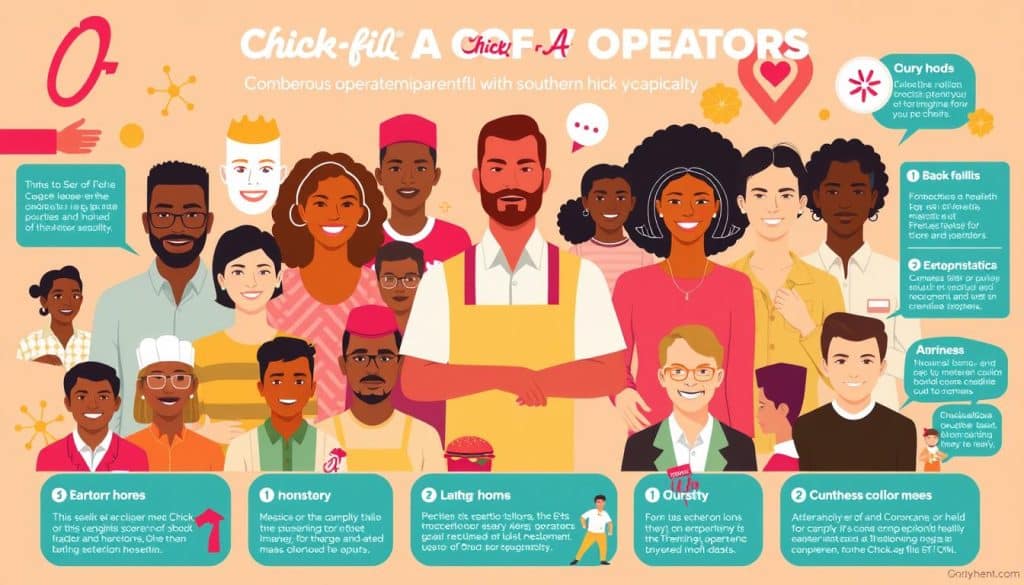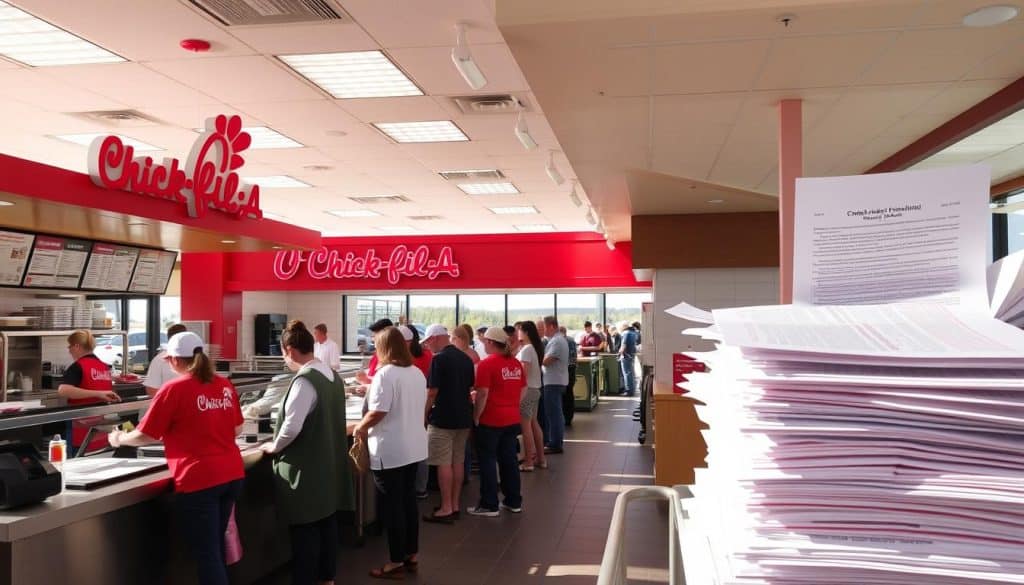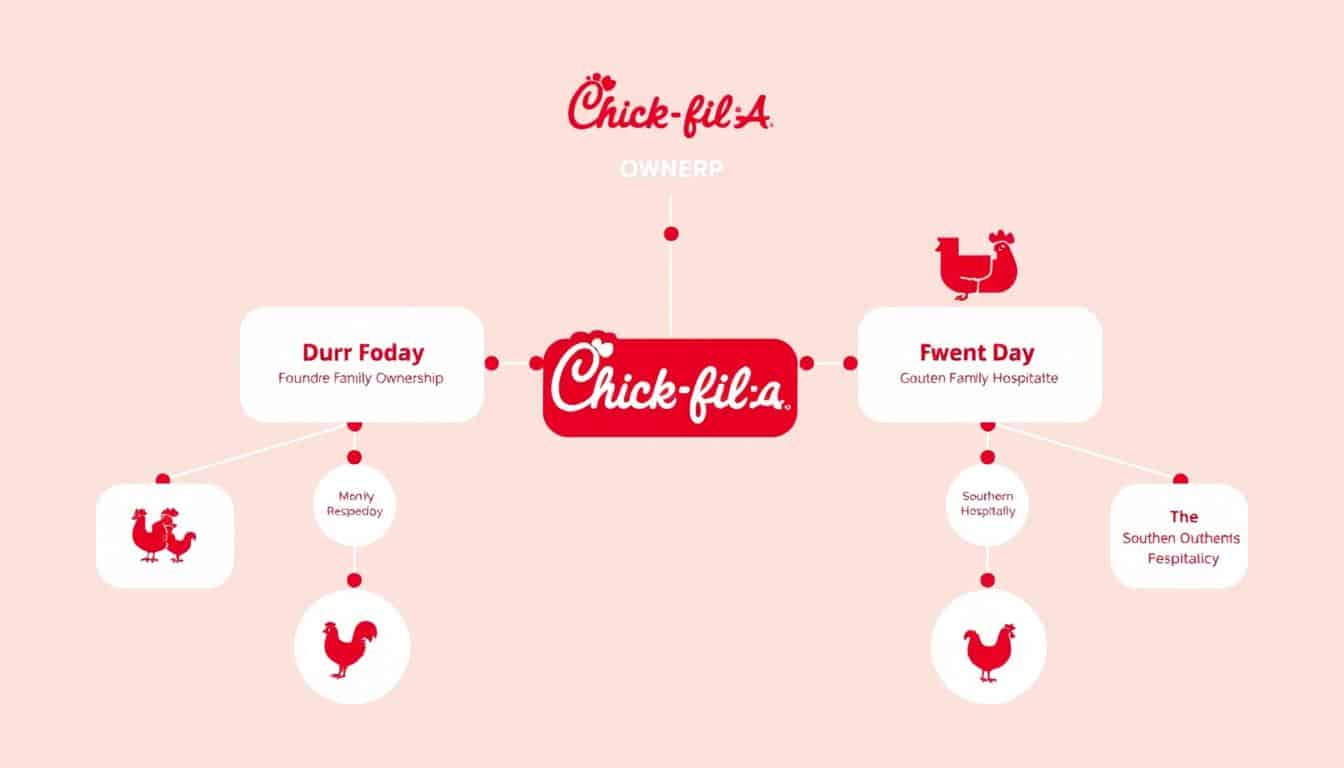Ever wondered why owning a Chick-fil-A is harder than getting into Harvard? This unique ownership structure is key to the brand’s success. It has over 2,600 locations in the U.S. and has grown by 16% in the last three years.
The mix of family ownership and a special franchise model makes it tough to become a franchisee. Only about 1% of applicants make it. This article explores Chick-fil-A’s ownership, its history, and what it means for those wanting to own a franchise.
Key Takeaways
- Chick-fil-A operates over 2,600 locations, mainly in the U.S.
- The brand has shown a remarkable 16% growth over the last three years.
- Getting to be a franchisee is tougher than getting into Harvard, with less than 1% success.
- The franchise model has a low failure rate of 2% over three years, compared to the industry’s 11%.
- Starting with a $10,000 investment, Chick-fil-A offers a high return of 900:1.
- In 2023, Chick-fil-A franchisees saw median sales of $9.27 million, showing the brand’s financial success.
The Structure of Chick fil A Ownership
Chick-fil-A has a unique ownership model that makes it stand out. Instead of owning the restaurants, franchise operators rent them from Chick-fil-A. The company owns the property and equipment, which helps keep the service and standards high across all locations. This setup makes it both challenging and rewarding for those looking to join the franchise.
Overview of Ownership Model
To become an operator, you need at least five years of professional experience and a clean financial record. The initial franchise fee is just $10,000, much lower than many competitors. Operators can manage one restaurant, but top performers might get to run up to three.
The way profits are shared, with operators getting 50% of net profits, shows Chick-fil-A’s commitment to its franchisees.
Importance of Family Ownership
Family ownership is key at Chick-fil-A. It brings stability and accountability to the business. Family members in management help shape the business’s direction and culture. This approach helps keep the brand’s high standards and makes Chick-fil-A a top choice for customers.
Historical Background of Chick fil A
Chick fil A has deep roots in family values and unique ownership. It was founded by Truett Cathy in 1967 in Atlanta, Georgia. The first restaurant opened at the Greenbriar Shopping Center, starting a remarkable journey in fast food.
Founder: Truett Cathy
Truett Cathy’s vision created a brand known to many. Before Chick-fil-A, he opened the Dwarf Grill in 1947. There, he focused on quality food and service, setting a high standard for customer satisfaction.
Evolution of Ownership Structure
The ownership of Chick fil A has grown while staying family-focused. The Cathy family leads, focusing on community and employee growth. This approach shows in their commitment to relationships and loyalty, like closing on Sundays.
Today, Chick-fil-A has 3,059 restaurants across 48 states, the District of Columbia, and Puerto Rico. They also have international locations. In 2023, they made $21.6 billion in revenue. Their unique ownership ensures high standards and a dedicated team.
Chick fil A’s Unique Franchise Model
Chick-fil-A’s franchise model is different from others. It has a very selective process for new franchise operators. Only about 1% are accepted, showing the brand’s high standards.
Franchisees are chosen for their commitment and ability to follow the brand’s mission. This ensures a consistent quality across all locations.
Franchise Operations vs. Corporate Ownership
Chick-fil-A’s franchise operators don’t own their restaurants. They are deeply involved in daily operations, focusing on hospitality and quality service. Each operator runs only one restaurant, dedicating their time to excellent customer experiences.
They pay a 15% royalty on gross sales and share profits with Chick-fil-A. This aligns their goals with the brand’s, keeping standards high.
The Role of Franchise Operators
Franchise operators at Chick-fil-A do more than manage businesses. They build community connections, linking the brand to local events. They receive extensive training and ongoing support to succeed.
They aim to meet financial targets and uphold Chick-fil-A’s values. This dedication helps the brand achieve impressive revenue, over $5 million per location. The model benefits both franchisees and customers, creating a thriving environment.
The Chick fil A Foundation
The Chick-fil-A Foundation works hard to make communities better. It focuses on education and support. This shows the company’s values of service and helping neighborhoods.
By giving back, franchise operators build strong ties with their communities. The foundation now focuses on fighting homelessness, hunger, and improving education.
Purpose and Mission
The Chick-fil-A Foundation aims to help communities through grants and programs. It gives out True Inspiration grants over $6 million each year. These grants range from $25,000 to $200,000, showing the foundation’s dedication to making a difference.
Chick-fil-A operators must share these community-oriented values. This ensures their businesses help social causes, meeting the chick fil a ownership requirements.
How It Influences Ownership Decisions
Chick-fil-A operators are expected to serve their communities. This shapes their decisions to own a franchise. They must show they care about local initiatives.
This commitment helps operators build a good reputation and succeed. The foundation’s new focus on homelessness, hunger, and education shows its dedication. It makes the Chick-fil-A Foundation initiatives key to owning a franchise.
Chick fil A’s Leadership Team
The leadership team at Chick-fil-A is key to the company’s success. Dan Cathy leads as Chairman, following in Truett Cathy’s footsteps. Andrew T. Cathy, the CEO, guides the company to grow while staying true to its values.
Key Figures in Management
Chick-fil-A’s leadership is focused on making decisions quickly. This helps franchise operators follow the brand’s rules closely. Rivera, who became an owner after a management program, shows how leadership and skill work together.
Governance and Ownership Responsibilities
Chick-fil-A’s governance shows its commitment to accountability. New franchisees spend a lot of time learning. They get hands-on experience with experienced operators.
This training helps them understand the brand and business well. It prepares them to keep high standards, helping the company succeed.
Diversity of Ownership Among Franchisees
Chick-fil-A picks franchise owners based on leadership skills and brand commitment. The application process is tough. Candidates need to show they can manage well and work full-time on their franchises.
This approach helps keep the brand’s values the same everywhere. It’s key to Chick-fil-A’s success.
Selecting Franchise Owners
Chick-fil-A values family ties and close groups in its franchise owners. Many franchises are run by families or people with strong connections. This shows a preference for control and consistency.
It means the selection process looks for established relationships. This might limit diversity in ownership.
Demographics of Franchise Operators
Chick-fil-A operators are mostly from family-run businesses. This is different from many other franchises. It creates both challenges and chances within the network.
Franchisees must mix brand standards with their personal touch and community ties. This is a big part of their job.

Financial Aspects of Chick fil A Ownership
Understanding the financial side of owning a Chick-fil-A franchise is key for those thinking about it. The initial investment is quite low, with a franchise fee of just $10,000. But, the total investment can be between $295,412 and $2,431,608. This range includes different costs and types of restaurants.
Initial Investment for Franchisees
The $10,000 fee is a small part of the total cost to buy a Chick fil A franchise. Chick-fil-A handles the setup costs. This lets new owners focus on running the business without a huge upfront cost.
Profit Sharing and Royalties
There’s more to the financial side than just the initial fee. Franchisees pay 15% of their sales as a royalty to Chick-fil-A. They also share 50% of their profits with the company. This setup aims to make both sides work together well.
With average sales of about $7,096,393 a year, many owners make good money. They can earn between $100,000 and $425,000 annually. This high earning power draws many applicants. But, only about 80 are chosen each year, showing how special this opportunity is.
Challenges in Ownership and Management
Owning a Chick-fil-A franchise comes with big hurdles. The company’s strict policies mean you must follow their rules closely. New owners face the challenge of making decisions that meet corporate standards.
Issues Faced by Franchisees
Franchise owners struggle to keep high service standards and meet local market needs. They can only operate one location, limiting their ability to tailor their business. They must follow Chick-fil-A’s rules on everything from staff to menu items.
This lack of control can be frustrating. It’s hard when the market wants something different from what Chick-fil-A allows.
Corporate Policies Impacting Operators
Chick-fil-A’s policies affect more than just how you run your business. Franchisees must give 15% of their sales and 50% of profits to the company. This can be a big financial burden.
Despite the financial rewards, which can be up to $425,000 a year, the costs are high. The initial investment can be from $295,412 to $2,431,608. This makes owning a Chick-fil-A a significant challenge.

Future of Chick fil A Ownership
The world of restaurant ownership is always changing. Chick-fil-A must keep up with these changes. They are looking into community-driven initiatives and sustainability in food service.
Understanding these trends can shape the future of Chick fil A franchises. It will affect how they are set up and supported.
Trends in Restaurant Ownership Models
The restaurant industry is moving towards digital transformation and customer engagement. Brands that focus on these areas do well. They meet the needs of today’s customers.
For Chick-fil-A, adapting its ownership model to new technology is key. Franchisees will get better tools for marketing and technology. This will help them keep up with the fast-changing digital world.
Potential Changes in Structure
Chick-fil-A might make its ownership structure more flexible in the future. This could attract a wider range of operators. They would bring different perspectives and local connections to their communities.
The company might also try new formats, like walk-up stores. These would offer convenience and speed. This move shows Chick-fil-A’s commitment to meeting today’s dining needs while staying true to its values.
Customer Perception of Ownership
The way Chick-fil-A is owned shapes how customers see the franchise. This setup lets local owners connect with their communities. It makes customers feel valued and appreciated.
By focusing on quality service and community involvement, these owners improve the customer experience. This approach makes Chick-fil-A stand out.
Impact of Franchise Ownership on Customer Experience
Franchise ownership greatly affects what customers experience at Chick-fil-A. Local owners are often there, ensuring the place is clean and welcoming. They also get involved in community events, which matches Puerto Rican values.
This hands-on approach leads to better interactions with customers. It boosts how people see the Chick-fil-A franchise.
Brand Loyalty and Ownership Dynamics
The unique way Chick-fil-A is owned helps build strong brand loyalty. Customers enjoy a consistent experience everywhere. This is because owners are committed to the brand’s values.
The profit-sharing model motivates owners to focus on customer satisfaction. They receive training and support from Chick-fil-A. This creates a work environment that values employees, leading to happy customers.
This commitment to excellence keeps customers coming back. They return for the quality food and service.
Conclusion: The Significance of Ownership in Chick fil A
Chick-fil-A’s ownership structure is key to its success. It uses a unique franchise model that focuses on family ownership. This model helps create a consistent brand experience for customers.
This approach has made Chick-fil-A a leader in the industry. It has also helped the company achieve high profits. These profits are higher than those of its competitors.
Summary of Key Points
Chick-fil-A values partnerships over just transactions. This helps create a sense of success among franchisees. They are usually limited to one location, which improves customer service.
This focus on core offerings keeps Chick-fil-A at the top. The company also grows organically, without needing outside money. Its decision to close on Sundays shows its commitment to values over profit.
Future Directions for Ownership Structure
Chick-fil-A might change its ownership structure in the future. This could help it meet new market demands and be more flexible. The current model has worked well, but changes could keep the brand relevant.
Looking ahead, Chick fil A might explore new ways to stay true to its values. This could involve innovative strategies while keeping the brand’s core principles intact.





